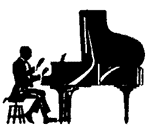|
|
Foster Piano Tuning
|
Welcome to the frequently asked questions sectionQuestion: Answer: Piano tuning is the process by which every string on the instrument is set to the correct tension so that the precise relationship between notes is achieved. The standard accepted compass for a modern piano is seven and a quarter octaves or eighty-eight notes. Each note may have one, two or three strings, known respectively as monochords, bichords or trichords. Where more than one string exists on a note they are all tuned to the same pitch, that is to say, in unison. Thus, a modern piano may have two hundred and twenty strings, depending on the individual design. In a typical piano the lower twelve notes are monochords, the next twenty notes are bichords and the remaining fifty-six notes are trichords. Modern strings are made of high tensile steel, the monochords and bichords normally being over-wound with copper to increase the mass of the string. The gauge (diameter) and length of the strings are smaller at the highest notes and increase towards the bottom notes. In simple terms, the pitch of each string is governed by its tension, diameter and length. Because of the graduation of the length and diameter the tension remains reasonably constant across the piano, approximately two hundred and twenty pounds at the bottom notes (monochords and bichords) and one hundred and eighty pounds on the higher notes (trichords). Thus the total tension on the frame of a modern upright piano is around eighteen tons. If you have any comments on this page in particularPlease enter the details below:Page visits - since March 2011. Copyright ©Robin Foster ©2000-2006 | |
